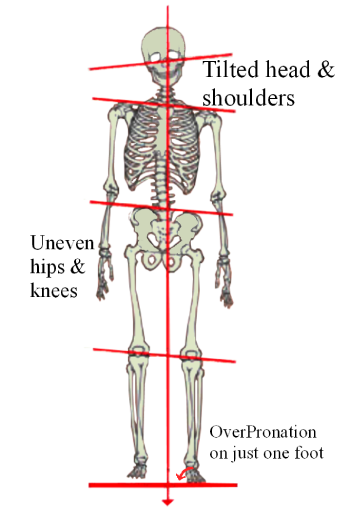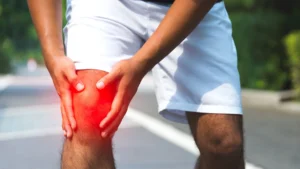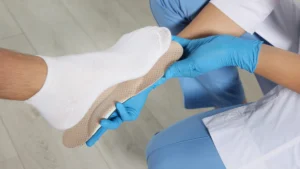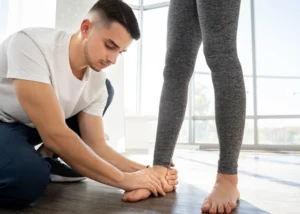Leg length discrepancies can affect your mobility, comfort, and overall quality of life. If you’re navigating this condition, understanding how to effectively use orthotics can significantly improve your situation. We will discover ten imperative steps tailored to help you manage your leg length discrepancy through the proper application of orthotics. Whether you are seeking pain relief, increased stability, or enhanced performance, these actionable steps aim to guide you toward achieving optimal results for your unique needs.
The Invisible Impact of Leg Length Discrepancy on Mobility
Leg length discrepancy can significantly affect your mobility, often in ways you may not immediately recognize. Subtle differences in leg length can lead to alterations in walking patterns and overall movement efficiency, making daily activities more challenging. As you navigate your environment, you might find that your body compensates for this imbalance, leading to discomfort and fatigue over time.
How Discrepancies Affect Gait and Posture
When you have a leg length discrepancy, your gait and posture can become unbalanced, affecting how you walk and stand. You may unconsciously adjust your stride or tilt your pelvis to compensate, which can lead to further issues in your hips, knees, and lower back. These adjustments not only impact your physical comfort but also your overall stability and coordination.
The Psychological Toll of Physical Imbalance
The discomfort resulting from a leg length discrepancy extends beyond the physical realm, often taking a toll on your mental well-being. You may experience feelings of frustration or embarrassment about your mobility challenges, which can lead to decreased self-esteem and social withdrawal. This mental strain can compound any physical discomfort you experience, making it necessary to address both the physical and psychological aspects of your condition.
It’s important to acknowledge that the psychological toll of living with a leg length discrepancy can influence your quality of life. You may find yourself hesitant to participate in activities you once enjoyed, due to fear of judgment or discomfort. Over time, these feelings can lead to anxiety and depression, impacting not only your physical health but also your relationships and overall happiness. Seeking support and effective management solutions, including orthotics, can help you regain confidence and alleviate some of these emotional burdens. Taking proactive steps toward addressing your leg length discrepancy is vital for both your physical and mental health.
Identifying the Root Cause: Seeking Professional Assessment
To effectively manage leg length discrepancy, it is vital to identify the root cause through a professional assessment. Consulting with a footcare specialist will ensure a comprehensive evaluation of your condition, whether it stems from structural issues, growth abnormalities, or underlying medical conditions. This step not only helps in understanding your situation better but also guides you toward appropriate treatment options tailored to your specific needs.
Understanding Clinical Evaluations and Imaging Techniques
Clinical evaluations and imaging techniques play a significant role in diagnosing leg length discrepancy. Your healthcare provider may use physical examinations, assessments of gait, and imaging tools like X-rays or MRI scans to determine the precise nature and extent of the discrepancy. These methods help in forming an accurate diagnosis and developing a targeted treatment plan, ensuring the best possible outcome for your situation.
The Role of a Podiatrist in Diagnosis
A podiatrist specializes in foot and lower limb conditions and is vital in diagnosing leg length discrepancies. Through a thorough assessment, they can identify biomechanical issues affecting your posture and gait, contributing to the assessment of your leg lengths. Furthermore, a podiatrist is well-versed in recognizing signs of underlying foot conditions that may be causing discrepancies, ensuring that you receive a comprehensive treatment strategy focused on your unique needs.
During your appointment, the podiatrist will evaluate your physical alignment, foot mechanics, and any related symptoms or pain. They may discuss your medical history and perform assessments to determine how your legs function both individually and together. This holistic approach allows the podiatrist to provide personalized recommendations, which may include specific orthotics, exercises, or referrals to other specialists for further evaluation. Ultimately, their expertise is vital in guiding you toward effective management of your leg length discrepancy.
Exploring Orthotic Solutions: Customized for Your Needs
When managing leg length discrepancies, customized orthotics can significantly improve your comfort and mobility. These devices are tailored specifically to your individual anatomy and requirements, ensuring that they address your unique challenges effectively. Collaborating closely with a healthcare professional will help you pinpoint the best approach for your situation, enabling you to enjoy enhanced functionality and well-being.
Types of Orthotics: From Insoles to Braces
Orthotic solutions come in various forms, each designed to cater to specific needs. Some common types include:
- Insoles
- Custom footbeds
- Ankle-foot orthoses (AFOs)
- Knee-brace orthotics
- Combination braces
Thou will find that choosing the right type is crucial for optimal results.
| Type of Orthotic | Purpose |
| Custom Insoles | Enhance comfort and balance |
| Custom footbeds | Address specific foot shapes |
| Ankle-foot orthoses (AFOs) | Stabilize the ankle and foot |
| Knee-brace orthotics | Provide support to the knee joint |
| Combination braces | Support multiple joints |
Factors Influencing Orthotic Selection: Comfort, Support, and Functionality
Selecting the right orthotic involves weighing several factors, including comfort, support, and functionality. You should aim for a balance that meets your personal needs while enhancing your mobility. Your healthcare provider will assist you in evaluating these elements to ensure your orthotics perform as intended.
- Level of support required
- Foot shape and size
- Daily activity level
- Sensitivities or preferences
- Aesthetic appeal
After considering these factors, you will be better equipped to make a more informed choice regarding your orthotic options.
As you explore the world of orthotics, understanding the nuances of comfort, support, and functionality will be vital to your success. Each individual may prioritize these elements differently based on personal experiences, lifestyle, and existing conditions. Effective communication with your provider will aid in achieving a harmonious combination of these aspects that suits you best.
- Evaluate your current foot health
- Consider any previous injuries
- Discuss your daily activities
- Understand the importance of fit
- Be open to adjustments over time
After all, finding the perfect orthotic solution often requires an adaptable approach throughout your journey.
The Fitting Process: Achieving Optimal Alignment
Achieving optimal alignment during the fitting process is vital for effective management of leg length discrepancy. You will work closely with your specialist to create a customized orthotic that accommodates your unique body mechanics. This tailored approach ensures that the orthotic fits well within your footwear while providing the necessary support to realign your posture and gait. The result is greater comfort and a significant reduction in discomfort as you go about your daily activities.
Importance of Precision in Measurements
Precision in measurements is crucial for the effectiveness of your orthotics. Inaccurate measurements can lead to improper fitting, which may exacerbate your leg length discrepancy. You should ensure that your healthcare provider takes detailed and accurate measurements of your feet and legs to create an orthotic that precisely meets your needs. This attention to detail will enhance your comfort and the orthotic’s overall effectiveness.
Adjustments and Follow-Up: Ensuring Long-Term Efficacy
Adjustments and follow-up appointments are important for maintaining the efficacy of your orthotic. After the initial fitting, you may find that minor tweaks are necessary to optimize comfort and alignment. Regular check-ins with your healthcare provider allow for timely adjustments, ensuring that your orthotics continue to support your needs as they evolve. Consistent follow-up can significantly enhance your orthotic’s performance, helping you maintain an active and pain-free lifestyle.
During follow-up visits, your healthcare provider will assess how well your orthotics are performing and if they’re yielding the expected results. You are encouraged to communicate any changes in comfort or functionality you’ve experienced. This collaborative approach allows for necessary adjustments that promote ongoing support and alignment. If you have developed new activities or your physical condition has changed, your orthotic can be modified to better accommodate these factors, ultimately enhancing your overall health and mobility.
Integrating Orthotics into Daily Life: Tips for Transition
Integrating orthotics into your daily routine can enhance comfort and mobility. To ease this transition, consider the following tips:
- Incorporate orthotics gradually in your daily activities.
- Choose supportive footwear to maximize the orthotics’ effectiveness.
- Track any changes in your comfort levels and adjust usage accordingly.
- Discuss concerns with your healthcare provider for tailored advice.
- Be patient and allow your body to adapt over time.
Perceiving the positive changes can motivate you to continue using your orthotic devices consistently.
Gradual Use: Adapting to Orthotic Devices
Starting with short periods of wear can help your body adjust to orthotic devices. Limit usage to a few hours each day, and progressively increase the duration as you become more comfortable. This gradual approach minimizes discomfort and enhances adaptation, ensuring that your body can acclimate effectively without feeling overwhelmed.
Complementary Exercises to Strengthen and Support
Incorporating complementary exercises alongside orthotic use is vital for developing strength and stability. Focus on exercises that target your lower body, emphasizing muscle balance and flexibility. These workouts not only address muscle imbalances caused by leg length discrepancy but also promote overall mobility and health. Choose exercises such as calf raises, glute bridges, and core stability workouts for optimal results.
Working on these exercises two to three times a week can significantly enhance the benefits of your orthotics. Strengthening your muscles helps mitigate potential discomfort, while also promoting better alignment and posture. Consult with a physical therapist to create a tailored exercise program that supports your individual needs and goals. This proactive approach allows you to remain active and engaged in your daily life as you adapt to your orthotics.
Monitoring Progress: Signs That Your Orthotics are Working
As you initiate on your journey with orthotics, monitoring your progress is vital to ensure they are effectively addressing your leg length discrepancy. Look for improvements in your overall comfort, mobility, and alignment. Regular checks on how well your orthotics fit and any changes in discomfort or pain levels will help validate their effectiveness. Consistent communication with your healthcare provider will also support your ongoing assessment and adjustments to your orthotic strategy.
Tracking Improvement in Pain and Mobility
To gauge the effectiveness of your orthotics, keep a detailed record of any changes in pain levels and mobility. You may notice decreased discomfort during activities that previously aggravated your condition or improved stability when walking. Note any increases in your activity level or ease of movement, as these can be significant indicators of your orthotics’ success. Frequent self-evaluation will empower you in your treatment journey.
Knowing When to Reassess Your Orthotic Strategy
It’s important to know when your orthotic strategy may need reevaluation. If you’re experiencing persistent pain, discomfort, or changes in your mobility, it may indicate that your orthotics are not functioning as intended or that your needs have evolved. Regularly assessing your situation with your healthcare provider will help you determine if adjustments to your orthotics or overall strategy are necessary. Being proactive in recognizing these signs can lead to improved outcomes and a better quality of life.
Manage Leg Length Discrepancy Final Words
Conclusively, managing leg length discrepancy with orthotics involves a systematic approach that can significantly improve your comfort and mobility. By following the 10 necessary steps outlined, you can ensure that your orthotics are appropriately tailored to your needs, promoting better alignment and reducing discomfort. Prioritize regular consultations with healthcare professionals, practice consistency in wearing your orthotics, and actively participate in your rehabilitation process. Adopting these strategies will empower you to effectively address leg length discrepancies and enhance your overall quality of life.





